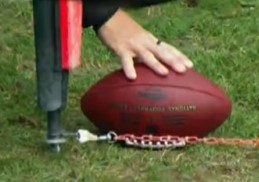When you watch a football game, you see officials watching the runners being tackled or run out of bounds. These officials then run out, grab the ball and place it on the field when they estimate it was advanced to. It is a field of 100 (US) or 110 (Canadian) yards, and the placement is the official’s best guess of how far the runner got. Is it precise? Hardly.

The offensive team has to gain 10 yards. That is an advancement measured in yards which is not a very precise measure.
If the ball is near to where that 10 yards would end, a carefully calibrated 10-yard long chain is brought out and placed where it is estimated the 10 yards would begin and the chain is stretched to where the ball is sitting.
Did they make it? Sometimes the decision is made with an inch difference. An inch would be 1/360th or less than 0.3% of the ten yards. So precise!
How silly is that? You guess by eye from the sidelines where the starting scrimmage for the ten yards is, and then guess where the ball should be placed. You then bring out a specifically calibrated measurement device to see if the effort – and the ability of the officials to estimate – got the necessary result. The estimation to begin the series of downs or at the end where the runner got to, is not at all precise but subject to much more than an inch or more of variance.
The input should match the precision of the measurement for the measurement to have any scientific significance.
The precision of this yardage measurement doesn’t match the lesser precision of the placements of balls; but, it does give an illusion of using precision in making the decision of whether a first down was achieved or not. With the precision of the measurement, fans forget the imprecision of the earlier estimates and even the context that got to the precise measurement.
It is easy to deceive the viewer by focusing into the detailed measurement. We often use less than solid statistics to remove focus from the issue.
It is also easy to deceive someone in an argument by attacking the argument’s support points instead of the argument itself. We counsel that creative strategies should not have more than three support points to avoid weaker points that can be attacked as if they were the argument itself. The more points, the more people are distracted from the main assertion.
For example, we launched a nutritious, high protein cereal with a great athlete endorsing it. Few cereals can claim “high protein” so it was a strong support for our nutritious claim. The well known athlete Wayne Gretzky, indicated that energy and nutrition were product benefits.
The cereal also had a fun star shape (it went with the name, Pro*Stars, and the extrusion die was available).
We did not include “fun star shape” in the strategy even though we could have. Why? Because it undermined the nutritious promise by suggesting frivolity and lightness. Not all attributes are benefits.
Creating an effective argument, which is what a creative strategy is, means leaving out things as well as including them. The support has to match the promised; like the precision of the measurement should match the data going in., If so, is it GIGO – garbage in – garbage out.
It is easy to lose sight of the big picture and quibble on a detail. That is the work of all lawyers. It is also true that many ideas can bog down in the details – the devil is there. You want to avoid the message getting distracted, if you are splitting hairs, even blonde hairs, even the fine blonde hairs on a gnat’s ass.
The real goal is to communicate meaning and have the receiver understand it.
In the case of the yard marker measurement deceptions, the result is that the crowd believes in the precision of the measurement and doesn’t question the overall imprecision of the game. If they did, it could lead to doubts about how time is kept (to the second at the end, but during the course of the game, it is kept very casually), whether the ball is in complete possession of someone or not, and other premises and presumptions in the game. Where judgements are involved, precision can help sell the judgment but the biases and noise in the decision will not go away.